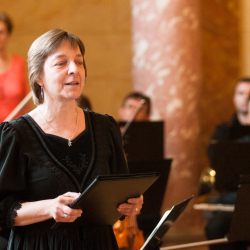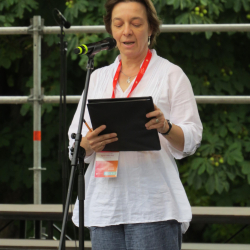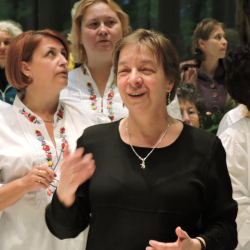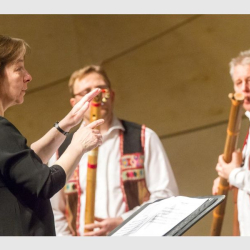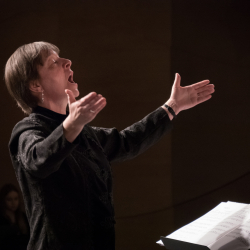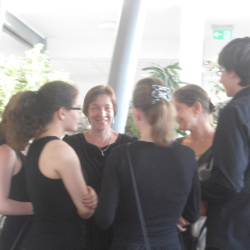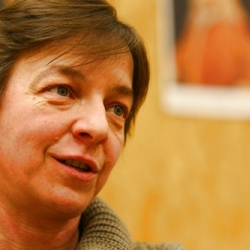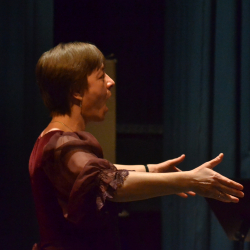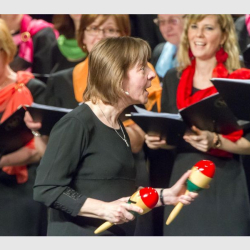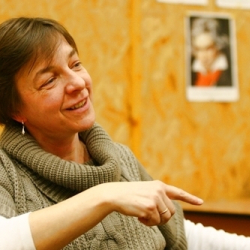Edélyi Ágnes
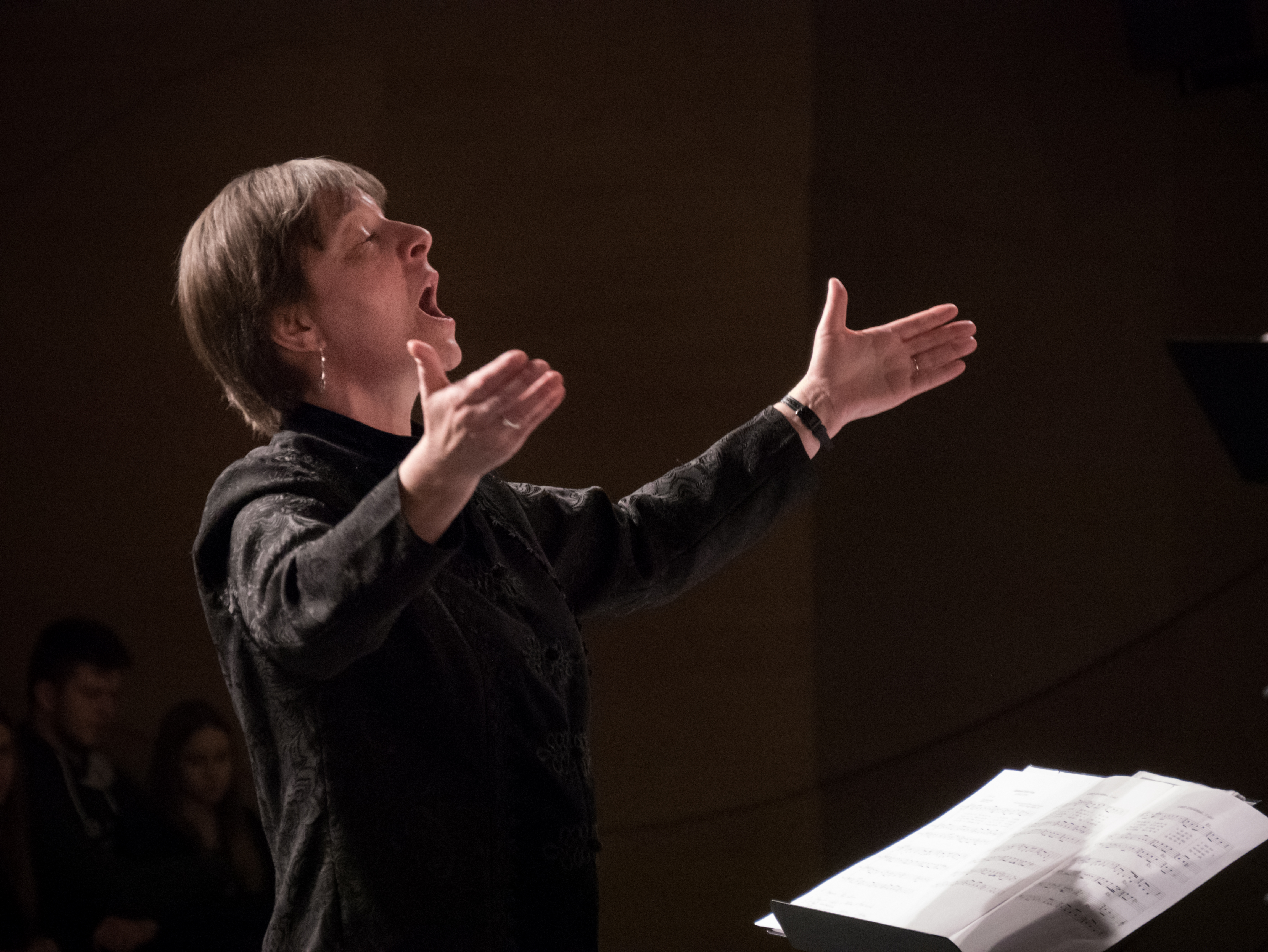
Ágnes Erdélyi has been the conductor since 1989. Graduated from the Liszt Ferenc Music Academy of Budapest, she has revitalised the community choir of Veszprém, opening new artistic perspectives for the ensemble. Erdélyi Ágnes is member of the Music Committee of the National Association of Hungarian Choirs and Orchestras-KÓTA. She got the conductor’s special prize of the Budapest International Choir Competition in 1993, and of the 1st National “Kodály Zoltán” Choir Competition. She is a sought after jury-member abroad, and Hungarian consultant of several international choral bodies, artistic director of the Vivace International Choir Festival. In 2005, her tirelessly enthusiastic and highly successful artistic activity was honoured with Gizella Prize, the highest cultural recognition of Veszprém City of County Rank.
Ms Erdélyi has an excellent command in German, Dutch and English.
Foreign repertoire for young voices – Hungary
Written by Ágnes Erdélyi
As a child in the nursery school in Nyíregyháza, I already met two thin books, or rather booklets, put together by Forrai Katalin, expert on early age music education. In these volumes, besides the Hungarian children’s songs and nursery rhymes, there was a pretty big selection of European children’s songs, usually for one voice, a cappella, or perhaps with some token-type accompaniment of a recorder and/or some percussion.
I still remember well to our favourites, as Sur le pont d’Avignon, or Ma come balli bella bimba - all was translated into Hungarian, the latter for instance by Weöres Sándor, one of the greatest virtuosos of our language. I remember well my first school-years, too - the late 60’ies, early 70’ies – in the famous Nyíregyháza music elementary school: we sang just everything, from Palestrina through Mozart to Mendelssohn and so on – but all in Hungarian, even the Latin texts were translated! It was a clear and strict expectation, or rather the stranglehold of restrictions. So when speaking of foreign repertoire, we have to separate what is inseparable by nature: music and text.
The so called Kodály – or Hungarian – Method focuses truly on the Hungarian folk music, but Kodály himself was absolutely aware of the fact, that the European tradition cannot be left out from any national curriculum. The main reason of it lies in the character of the Hungarian children’s songs, as they are either pentachordal or pentatonic melodies, being fundamentally different than the European tonal system with its rich major/minor variations. It is quite obvious that without the European (foreign) repertoire, just with the means of our own musical heritage, the wide and varied lands of Classical Music cannot be conquered.
However, the ways and means got different with the times. It happened, that I knew both the old and the new solutions of the same old and also some new problems.
So let’s go back to the “in Hungarian only” times, which were quite rigid at this point, but also offered a great variety of foreign repertoire, original compositions as well as arrangements or adaptations. Botka Valéria and Csányi László – leaders of the Radio Children’s Choir – edited a vast collection of music for children’s choirs, published by Editio Music Budapest. The best composers of the time - Bárdos Lajos, Szőnyi Erzsébet, Sebestyén András and others – introduce the European children’s and folk literature to the young: this is when many accessible, likeable suites were born, some a cappella, others as the “Far away countries” with piano accompaniment. The children still love them!
I graduated from the Liszt Ferenc Academy of Music in Budapest in 1986 – right before the change of the social system. At that time, the “in original language only” took over the platform, opening a new world, and raising some new questions, especially regarding the less taught (French, Italian, Spanish,) or the so called smaller languages. But as the children of our times know more and more about the world, they get used to foreign languages, including learning these foreign languages, and they are not frightened by looking at a piece in Catalan or Swedish as their parents were. Even my young singers can surprise me, how easily they learn the songs that are in English – the Latin of the 21st century...
As a solfeggio-teacher as well as conductor of a children’s, youth and adult choir, I use foreign repertoire day by day, hour by hour. Sometimes we sing in original language, sometimes in translation, and quite often I improvise a solid piano accompaniment for my solfeggio students in the music school I work. My very favourite at this point the “Énektár” by Pécsi Géza, where a huge chapter is dedicated to the songs of other nations – I use this repertoire very much, as the 6/8 or the changing metre cannot be taught on Hungarian material. I also like the Choral music of 500 years and 1000 years, two wonderful collections, compiled by Forrai Miklós in the early 1940’ies. Roughly thirty years later the publishing Editio Musica Budapest got back to the original idea: to put the Hungarian text and the original into the score.
Working with different age-groups, I find the following: especially the young are ready to take the challenge to sing foreign repertoire in original language, as long as the piece is interesting/exciting/unusual musically, and there is not too much text in it. I try to make a good balance – for the sake of my young singers (Csermák Children’s Choir of the Music School: 10-15 years old, Veszprém City Choir Youth Group: 15-24 years) as well as for the sake of the audience. In my thematic/representational concerts – including the annual Christmas concert of my three choirs – I use foreign repertoire extensively, some in translation, some in original language, because it is also essential to introduce the special flavours of the different languages.
I experienced with my choirs and the children’s choirs of the Vivace International Choir Festival the same: up to a certain point, the young enjoy to sing fine repertoire in original language, and they can cope with it. A long strophic song is a problem, however. I often discuss the question with my colleagues and friends, as the general circumstances – the length of the rehearsing period, who is singing, what, for whom – influences tremendously the actual ratio.
Every summer I lead a week-long singing camp, absolutely open whomever to come – so it is not a choir, rather a temporary singing-together-community of young children and youth. I prepare some translations myself (speaking German and Flemish, knowing Latin and English as well), or ask volunteer translators, who also know other languages. If the piece is attractive – or funny, as for instance “El crocodile come fa” – and tells a story, then I keep the singable translation by the hand. And decide to use it or not, on the spot.
The collections, published by Europa Cantat, and many national publishing houses, are good sources, but they are above the financial capacity of the everyday Hungarian music teachers or conductors at the moment.
It is often told that Hungarian is extremely difficult language, impossible to learn. My experience with the Vivace choirs does not confirm this – it was neither more difficult, nor less successful than any other used languages from Latvian to Chinese, from Russian to Italian, from Japanese to Swahili. But the pieces were appropriate for the young, exciting, or funny, with not much text, and clear instructions for pronunciation. Little choreography/movements or plays make things usually easier. Another prejudice, that into Hungarian, you can translate just everything, while the other way around kills the originality of the music. It is not true either – as the ¾ metre is in a way “against” the Hungarian language and very difficult to make a singable text-adaptation; and choral people still remember the thrilling performance of late Darázs Árpád’s American youth choir, singing Kodály’s “The Aged” in the early 80’ies, unforgettably and - in English.
Of course, singing in original language cannot be a question in the professional concert-life. But with amateur choirs and especially children, we should take into consideration several factors, before deciding to perform a particular piece in original language – or in a translation.
The key is: that the young singers should get a close and good picture of the foreign repertoire – which is not foreign any longer at the moment they know what they are singing about, and enjoy the taste of the language. On the long run, getting acquainted with the choral treasures of other nations, teaches us to appreciate our own values more.
With the kind permission of SCIC. Published in English and in Catalan in March 2012,
in La Circular, Magazine of the Secretariat de Corals Infantils de Catalunya
Translated by C.Szalai Ágnes
